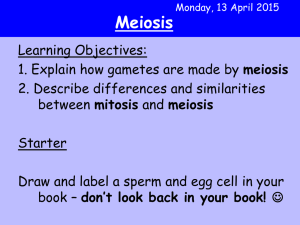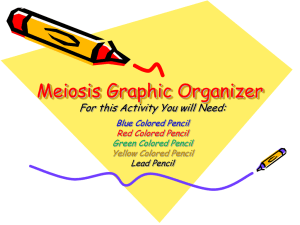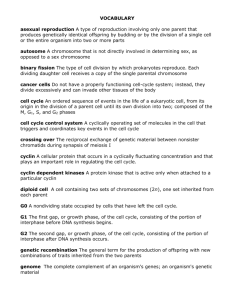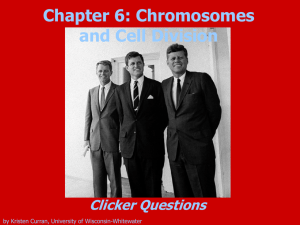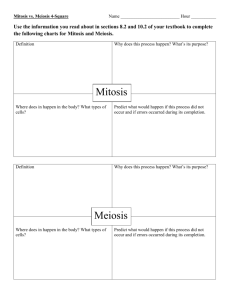AP LAB # 3: MITOSIS AND MEIOSIS
advertisement
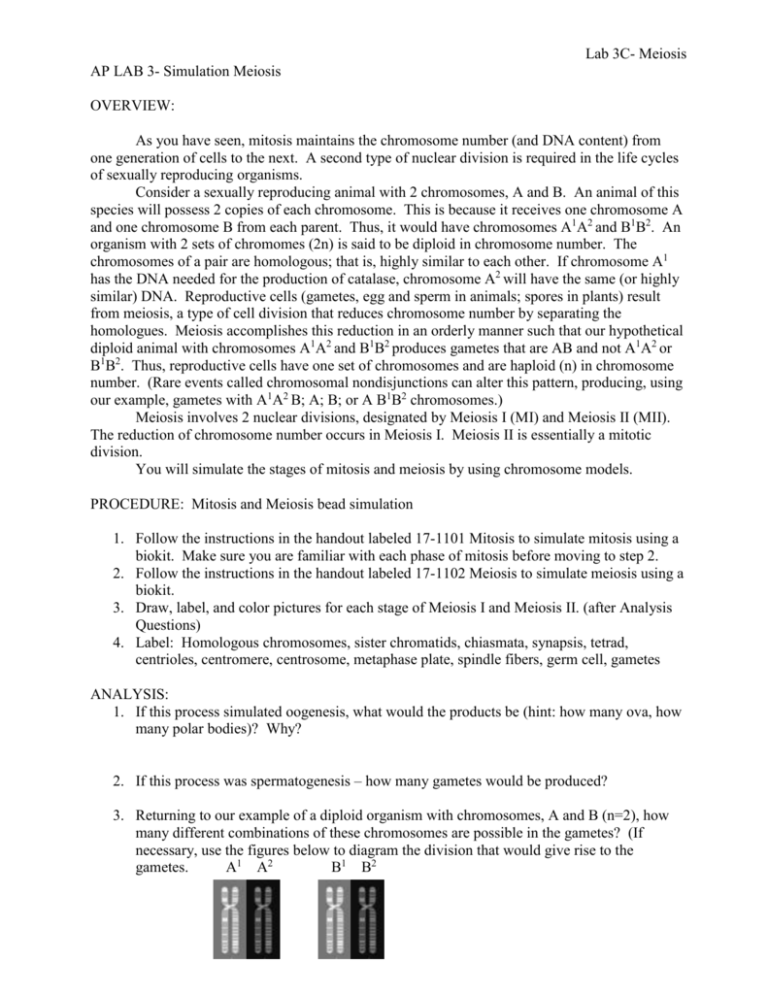
Lab 3C- Meiosis AP LAB 3- Simulation Meiosis OVERVIEW: As you have seen, mitosis maintains the chromosome number (and DNA content) from one generation of cells to the next. A second type of nuclear division is required in the life cycles of sexually reproducing organisms. Consider a sexually reproducing animal with 2 chromosomes, A and B. An animal of this species will possess 2 copies of each chromosome. This is because it receives one chromosome A and one chromosome B from each parent. Thus, it would have chromosomes A1A2 and B1B2. An organism with 2 sets of chromomes (2n) is said to be diploid in chromosome number. The chromosomes of a pair are homologous; that is, highly similar to each other. If chromosome A1 has the DNA needed for the production of catalase, chromosome A2 will have the same (or highly similar) DNA. Reproductive cells (gametes, egg and sperm in animals; spores in plants) result from meiosis, a type of cell division that reduces chromosome number by separating the homologues. Meiosis accomplishes this reduction in an orderly manner such that our hypothetical diploid animal with chromosomes A1A2 and B1B2 produces gametes that are AB and not A1A2 or B1B2. Thus, reproductive cells have one set of chromosomes and are haploid (n) in chromosome number. (Rare events called chromosomal nondisjunctions can alter this pattern, producing, using our example, gametes with A1A2 B; A; B; or A B1B2 chromosomes.) Meiosis involves 2 nuclear divisions, designated by Meiosis I (MI) and Meiosis II (MII). The reduction of chromosome number occurs in Meiosis I. Meiosis II is essentially a mitotic division. You will simulate the stages of mitosis and meiosis by using chromosome models. PROCEDURE: Mitosis and Meiosis bead simulation 1. Follow the instructions in the handout labeled 17-1101 Mitosis to simulate mitosis using a biokit. Make sure you are familiar with each phase of mitosis before moving to step 2. 2. Follow the instructions in the handout labeled 17-1102 Meiosis to simulate meiosis using a biokit. 3. Draw, label, and color pictures for each stage of Meiosis I and Meiosis II. (after Analysis Questions) 4. Label: Homologous chromosomes, sister chromatids, chiasmata, synapsis, tetrad, centrioles, centromere, centrosome, metaphase plate, spindle fibers, germ cell, gametes ANALYSIS: 1. If this process simulated oogenesis, what would the products be (hint: how many ova, how many polar bodies)? Why? 2. If this process was spermatogenesis – how many gametes would be produced? 3. Returning to our example of a diploid organism with chromosomes, A and B (n=2), how many different combinations of these chromosomes are possible in the gametes? (If necessary, use the figures below to diagram the division that would give rise to the gametes. A1 A2 B1 B2 Lab 3C- Meiosis 4. Using your answer to number 3, and given the following, n (chromosome Number of possible number ) combinations in the gametes 3 8 4 16 5 32 state a formula for calculating the number of possible chromosome combinations in the gametes based on the value of n. Number of chromosome combinations = 5. For humans, n = 23. Using your formula from question 4, how many possible combinations of chromosomes are there for human gametes? _______________________ 6. For our hypothetical organism with 2 chromosomes, A and B, when 2 members of the species reproduce, how many possible combinations of chromosomes are there for the offspring? ______________ A1 A2 B1 B2 X A1 A2 B1 B2 X 7. Compare and contrast mitosis and meiosis by filling out this table: Mitosis Meiosis Chromosome number of parent cells Number of DNA replications Number of divisions Number of daughter cells produced Chromosome number of daughter cells Purpose/ Function Drawings:



